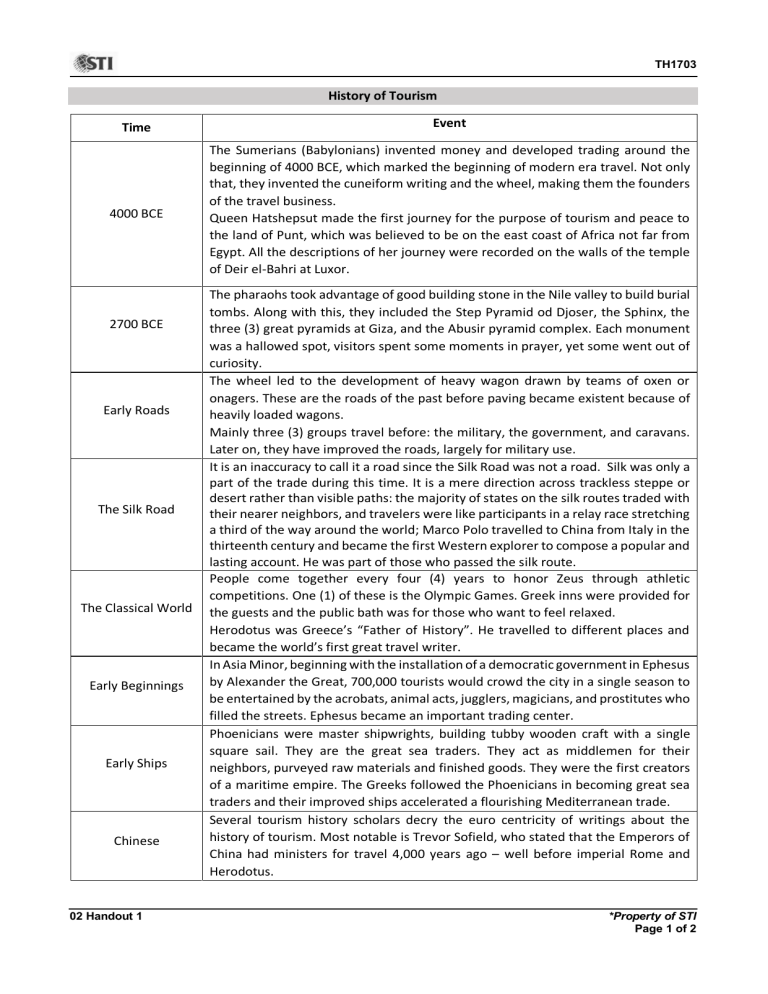
TH1703 History of Tourism Time Event 4000 BCE The Sumerians (Babylonians) invented money and developed trading around the beginning of 4000 BCE, which marked the beginning of modern era travel. Not only that, they invented the cuneiform writing and the wheel, making them the founders of the travel business. Queen Hatshepsut made the first journey for the purpose of tourism and peace to the land of Punt, which was believed to be on the east coast of Africa not far from Egypt. All the descriptions of her journey were recorded on the walls of the temple of Deir el-Bahri at Luxor. 2700 BCE Early Roads The Silk Road The Classical World Early Beginnings Early Ships Chinese 02 Handout 1 The pharaohs took advantage of good building stone in the Nile valley to build burial tombs. Along with this, they included the Step Pyramid od Djoser, the Sphinx, the three (3) great pyramids at Giza, and the Abusir pyramid complex. Each monument was a hallowed spot, visitors spent some moments in prayer, yet some went out of curiosity. The wheel led to the development of heavy wagon drawn by teams of oxen or onagers. These are the roads of the past before paving became existent because of heavily loaded wagons. Mainly three (3) groups travel before: the military, the government, and caravans. Later on, they have improved the roads, largely for military use. It is an inaccuracy to call it a road since the Silk Road was not a road. Silk was only a part of the trade during this time. It is a mere direction across trackless steppe or desert rather than visible paths: the majority of states on the silk routes traded with their nearer neighbors, and travelers were like participants in a relay race stretching a third of the way around the world; Marco Polo travelled to China from Italy in the thirteenth century and became the first Western explorer to compose a popular and lasting account. He was part of those who passed the silk route. People come together every four (4) years to honor Zeus through athletic competitions. One (1) of these is the Olympic Games. Greek inns were provided for the guests and the public bath was for those who want to feel relaxed. Herodotus was Greece’s “Father of History”. He travelled to different places and became the world’s first great travel writer. In Asia Minor, beginning with the installation of a democratic government in Ephesus by Alexander the Great, 700,000 tourists would crowd the city in a single season to be entertained by the acrobats, animal acts, jugglers, magicians, and prostitutes who filled the streets. Ephesus became an important trading center. Phoenicians were master shipwrights, building tubby wooden craft with a single square sail. They are the great sea traders. They act as middlemen for their neighbors, purveyed raw materials and finished goods. They were the first creators of a maritime empire. The Greeks followed the Phoenicians in becoming great sea traders and their improved ships accelerated a flourishing Mediterranean trade. Several tourism history scholars decry the euro centricity of writings about the history of tourism. Most notable is Trevor Sofield, who stated that the Emperors of China had ministers for travel 4,000 years ago – well before imperial Rome and Herodotus. *Property of STI Page 1 of 2 TH1703 Polynesians Europeans The Grand Tour Americans Small dugout canoes that are not over 40 feet in length were used for voyages. Polynesians from the Society Islands travelled to Hawaii, a distance of over 2000 miles. Navigation was accomplished by observing the position of the sun and stars, ocean swells, clouds and bird flights. The collapse of the Roman Empire in the fourth and fifth centuries spelled disaster for pleasure travel and tourism in Europe. During the Dark Ages (from the fall of the Western Roman Empire in 476 C.E. to the beginning of the modern era in 1450 C.E.), only the most adventurous persons would travel since traveling during this period was dangerous. The most notable exception to this in Europe were the Crusades. England’s King Richard II required pilgrims to carry permits, the forerunner of the modern passport. The Grand Tour of the seventeenth and eighteenth centuries was made by diplomats, businesspeople, and scholars who travelled to Europe. It is in purpose of educational experience degenerating into simple pursuit of pleasure. Early travel was on foot or on horseback, but travel by small boat or canoe provided access to the interior of the country. As roads were built, stagecoach travel became widespread. Then, construction of railroads across the country popularized rail travel in 1869. References: Jr, C. M., & Bosangit, C. A. (2007). Introduction to tourism: A comprehensive guide to the travel and tourism industry. Pasig City: Anvil Publishing, Inc. Lim, R. D. (2012). Principles & scopes of tourism. Manila: Mindshapers Co., Inc. 02 Handout 1 *Property of STI Page 2 of 2




